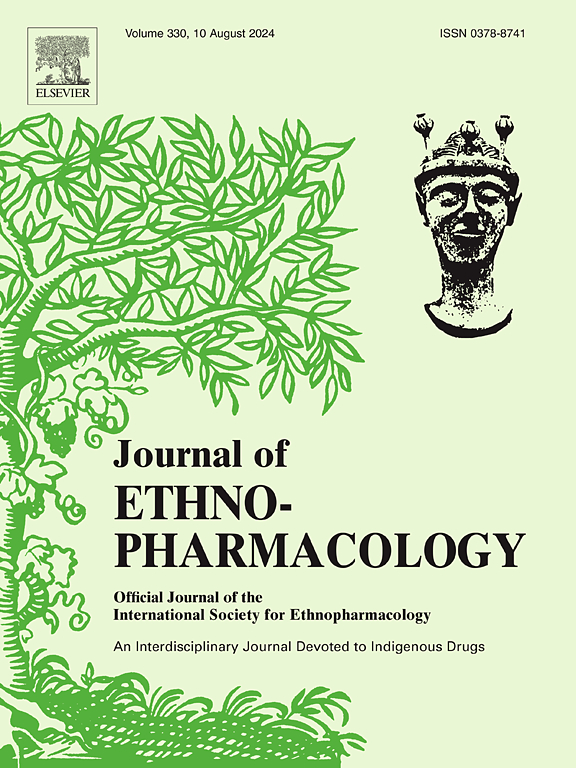基于原料和加工产品的多种应用理论,发现石膏作为退热剂的物质基础和机理。
IF 5.4
2区 医学
Q1 CHEMISTRY, MEDICINAL
引用次数: 0
摘要
民族药理学相关性:石膏(CaSO4·2H2O)是中医公认的经典矿物药物,传统上用于治疗发烧。然而,其具体的生物活性成分及其作用的潜在分子机制尚未完全阐明。研究目的:为了解决这一知识空白,我们通过结合金属谱、肠道微生物群谱和血清代谢组学分析,系统地阐明了石膏的解热物质基础和潜在机制。材料与方法:首次采用金属化学谱法,通过比较石膏与煅烧石膏的血清成分,阐明其解热成分。随后,本研究通过监测大鼠体温和炎症因子的变化,研究了石膏、煅烧石膏和关键成分在脂多糖(LPS)诱导的发热模型中的差异解热作用。此外,通过western blotting (WB)、定量实时PCR (qPCR)和肠道微生物群与代谢组学的结合,探讨了潜在的机制。结果:Mg、Ca、Zn、Mo是石膏的主要活性物质。此外,研究证明,石膏和关键元素(Mg, Ca, Zn, Mo)表现出显著的解热作用,而煅烧石膏则没有。WB和qPCR分析显示,石膏暴露组下丘脑组织环氧化酶-2 (COX-2)表达降低。血清代谢组学分析表明,石膏的解热作用可能涉及初级胆汁酸的生物合成。涉及肠道菌群的关联分析表明,石膏可能通过下调拟杆菌、Ruminococcaceae和Roseburia抑制发热,导致15-羟基-5,8,11,13-二十碳四烯酸、PC(16:1(9Z)/0:0)、PC(22:6(4Z,7Z,10Z,13Z,16Z,19Z)/0:0)和PC(P-18:0/PGJ2) 5种重要代谢物下调。涉及粪便微生物群移植的实验为肠道细菌参与促进与石膏相关的解热作用提供了额外的证据。结论:本研究首次确定了石膏的核心解热成分为关键元素(Mg、Ca、Zn、Mo),并建立了多维度的“矿物质组成-肠道微生物-宿主代谢”相互作用网络。本研究结果为优化矿物基中药制剂的质量标准提供了机理见解。本文章由计算机程序翻译,如有差异,请以英文原文为准。

The discovery of the material basis and mechanism of gypsum as an antipyretic based on the theory of the diverse applications of raw and processed products
Ethnopharmacological relevance
Gypsum (CaSO4·2H2O), recognized as a classical mineral medicine in traditional Chinese medicine (TCM), has been traditionally used to treat fever. However, the specific bioactive constituents and the underlying molecular mechanisms of its action have yet to be fully elucidated.
Aim of the study
To address this knowledge gap, we systematically elucidated the antipyretic material basis and underlying mechanisms of gypsum through integrating the analysis of metal profile, gut microbiota profiling, and serum metabolomics.
Materials and methods
Metal chemical profiling was firstly used to elucidate the antipyretic composition by comparing the serum composition of gypsum and calcined gypsum. Subsequently, this research investigated the differential antipyretic effects of gypsum, calcined gypsum and key elements in a lipopolysaccharide (LPS)-induced fever model in rats by monitoring changes in body temperature and inflammatory cytokines. Furthermore, the underlying mechanism was explored through western blotting (WB), quantitative real-time PCR (qPCR), and gut microbiota in conjunction with metabolomics.
Results
The results reveal that Mg, Ca, Zn, and Mo were the strong candidates for active substances of gypsum. Furthermore, the research proved that gypsum and key elements (Mg, Ca, Zn, Mo) exhibits a notable antipyretic effect, while calcined gypsum does not. WB and qPCR analyses revealed a reduction in the expression of cyclooxygenase-2 (COX-2) in hypothalamic tissue in the gypsum-exposed group. Metabolomics profiling of serum suggests that the antipyretic effect of gypsum may involve primary bile acid biosynthesis. Association analysis involving gut microbiota indicated that gypsum may lead to the downregulation of five significant metabolites, including 15-Hydroxy-5,8,11,13-Eicosatetraenoic Acid, PC(16:1 (9Z)/0:0), PC(22:6 (4Z,7Z,10Z,13Z,16Z,19Z)/0:0) and PC(P-18:0/PGJ2), by downregulating Bacteroides, Ruminococcaceae and Roseburia to inhibit fever. Experiments involving fecal microbiota transplantation provide additional evidence for the involvement of gut bacteria in facilitating the antipyretic effects associated with gypsum.
Conclusions
This study pioneers in identifying the key elements (Mg, Ca, Zn, Mo) as the core antipyretic component of gypsum while establishing a multidimensional “mineral composition-gut microbiota-host metabolism” interaction network. Our findings provide mechanistic insights for optimizing quality standards of mineral-based TCM formulations.
求助全文
通过发布文献求助,成功后即可免费获取论文全文。
去求助
来源期刊

Journal of ethnopharmacology
医学-全科医学与补充医学
CiteScore
10.30
自引率
5.60%
发文量
967
审稿时长
77 days
期刊介绍:
The Journal of Ethnopharmacology is dedicated to the exchange of information and understandings about people''s use of plants, fungi, animals, microorganisms and minerals and their biological and pharmacological effects based on the principles established through international conventions. Early people confronted with illness and disease, discovered a wealth of useful therapeutic agents in the plant and animal kingdoms. The empirical knowledge of these medicinal substances and their toxic potential was passed on by oral tradition and sometimes recorded in herbals and other texts on materia medica. Many valuable drugs of today (e.g., atropine, ephedrine, tubocurarine, digoxin, reserpine) came into use through the study of indigenous remedies. Chemists continue to use plant-derived drugs (e.g., morphine, taxol, physostigmine, quinidine, emetine) as prototypes in their attempts to develop more effective and less toxic medicinals.
 求助内容:
求助内容: 应助结果提醒方式:
应助结果提醒方式:


